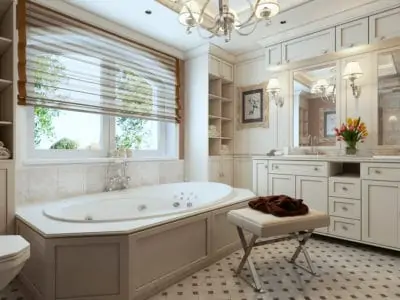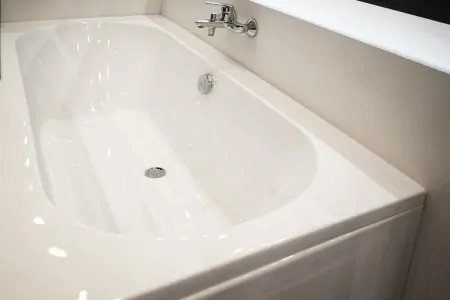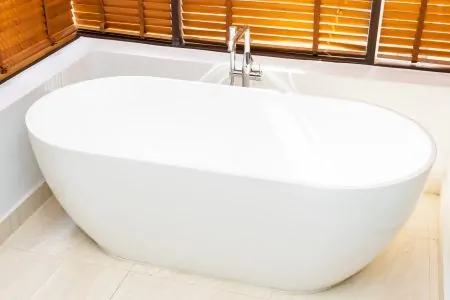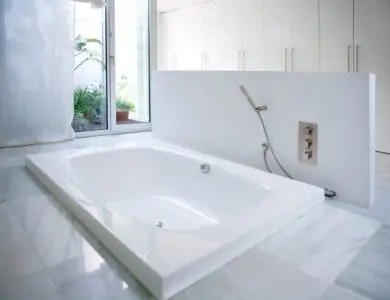If it’s time for a bathroom remodel, getting your measurements right when replacing the bathtub could be tricky. Luckily, there are standard bathtub dimensions to make life a little easier.
However, these bathtub sizes vary between different styles, so which type of tub you want should be the first question to ask. Let’s explore bathtub dimensions to give you a better idea.
Key Takeaways
- Standard bathtub dimensions vary by style, including freestanding, alcove, drop-in, undermount, corner, walk-in, and whirlpool bathtubs.
- Typical wall-mounted tubs are 60 inches long, 30 to 32 inches wide, and 14 to 20 inches deep.
- Consider the size of your bathroom when choosing the right bathtub style, as some require more space than others.
- Whirlpool bathtubs offer luxury features like water jets, LED lights, and speakers, but are more expensive and require professional installation.
Standard Bathtub Dimensions
The idea of standardizing bathtub dimensions makes it easier for you to plan your bathroom remodel because you should have an idea of sizes before you start. But not all bathtubs are the same, and the measurements vary.
If you want a typical wall-to-wall tub, you should expect it to be 60 inches in length by 30 to 32 inches in width, with a depth of between 14 and 20 inches. But what about other styles of bathtubs?
Freestanding Bathtub
Freestanding bathtubs do not make contact with any wall, hence the name. They are among the most stylish in design and appearance, often with sleek curves and modern lines. They are also heavier than wall-mounted bathtubs because they are freestanding and need to stay in situ.
These types of tubs are suitable for larger bathrooms because they take up more room, and they come in a variety of materials, from copper to ceramic. You would need a space of between 110 and 160 sq ft to accommodate a bathtub of this size.
Typical standard dimensions for a freestanding bathtub are:
- 60 inches (5ft) long by 30 inches (2.5ft) wide and 19 inches (1.89ft) in depth.
- Smaller models can be 55 inches (4.58ft) by 27 inches(2.25ft) and 15 inches (1.25ft) in depth.
- Bigger ones stretch to 72 inches (6ft) long by 32 inches (2.67ft) and 20 inches (1.6ft) in water depth.
Alcove Bathtubs
These bathtubs are among the most common on the market and are considered to be the easiest to install. While they are convenient and affordable, they are also on the small side. This makes them ideal for a small bathroom measuring between 40 and 110 sq ft.
And because they fit between 3 walls, they are also excellent for including a shower enclosure as well. That’s why many of these alcove bathtubs are P-shaped to allow extra room for showering.
Typical standard sizes for an alcove bathtub are:
- 60 inches (5ft) by 30 inches (2.5ft) and 16 inches (1.3ft) in water depth.
- Smaller versions often measure 45 inches (3.75ft) by 30 inches (2.5ft) and 14 inches (1.16ft) depth.
- For larger sizes, you are looking at 72 inches (6ft) by 42 inches (3.5ft) and 20 inches (1.6ft) of water depth.
Drop-In Bathtubs
Most bathtubs have a curved or flat skirt or apron on the front-facing side. Drop-in tubs have no skirts or panels and are typically installed in an alcove or peninsula that juts out into the bathroom space.
These types of bathtubs can be installed in an alcove or, if you have a larger bathroom, as a freestanding unit. They are larger than standard alcove baths, so you need to allocate extra space. These tubs would suit medium bathrooms measuring around 100 to 110 sq ft.
Standard dimensions for drop-in tubs include:
- 60 inches (5ft) by 30 inches (2.5ft) and 16 inches (1.3ft) in water depth.
- Smaller versions often measure 45 inches (3.75ft) by 30 inches (2.5ft) and 14 inches (1.16ft) depth.
- For larger sizes, you are looking at 72 inches (6ft) by 32 inches (2.67ft) and 20 inches (1.6ft) in depth.
Undermount Bathtubs
Undermount bathtubs are identical to drop-in bathtubs, except that the rim of the bathtub is concealed by a small deck-top made of tiles or stone. While these tubs are more pleasing to the eye compared to drop-in models, you are paying extra for all that luxury.
Undermount bathtubs require a little more space than standard tubs, so they are unlikely to fit in a small bathroom. However, if you have a medium to large bathroom measuring around 100 to 160 sq ft, you should be fine.
Standard dimensions for undermount bathtubs are as follows:
- 60 inches (5ft) by 30 inches (2.5ft) and 16 inches (1.3ft) in water depth.
- Smaller versions often measure 45 inches (3.75ft) by 30 inches (2.5ft) and 14 inches (1.16ft) depth.
- For larger sizes, you are looking at 72 inches (6ft) by 32 inches (2.67ft) and 20 inches (1.6ft) in depth.
Corner Bathtubs
Corner bathtubs are among the most luxurious models you can buy. Typically, they are triangular in shape with a curved front-facing panel. These tubs are often found in master bathroom suites and are ideal for long soaks to help you destress after a long day at work.
Because they are a luxury addition to your bathroom, you can get corner bathtubs with water jets that massage and soothe joints and body parts, enhancing your bathing experience.
Corner bathtubs take up far more floor space than standard tubs, so you would need a large master bathroom of 110 sq ft or above.
Typical sizes are:
- 60 inches by 60 inches (5ft by 5ft) and a water depth of 20 inches (1.6ft).
- Smaller tubs run at 48 inches by 48 inches (4ft by 4ft) and a water depth of 18 inches (1.5ft).
- Larger sizes measure 72 inches by 72 inches (6ft by 6ft) and have a water depth of 20 inches (1.6ft).
Walk-In Bathtubs
Walk-in bathtubs are a great option for older people and those with mobility issues. They have a door that opens on the side to give you easier access. You also get a seat, often at comfort height, which conforms to the American Disability Act (ADA).
The emphasis is very much on safety, with handrails to prevent slippage and anti-slip floors and make you feel more stable. The downside is the cost because these tubs are not cheap, and they also require a professional to perform the installation.
They also take a lot of energy to heat, which places a significant burden on your water heater and increases your energy costs. Walk-in tubs are compact in length but quite bulky in depth and width, so they would suit a medium-size bathroom.
Standard dimensions include:
- 60 inches long (5ft) by 30 inches (2.5ft) and 30 inches (2.5ft) deep.
- Smaller sizes are 48 inches long (4ft) by 28 inches wide (2.3ft) and 30 inches (2.5ft) deep.
- Larger sizes are 60 inches (6ft) by 36 inches wide (3ft) and 30 inches (2.5ft) deep.
Whirlpool Bathtubs
Whirlpool bathtubs are the ultimate statement in luxury. They have water jets that massage and relieve stress on joints and body parts, and some even have LED lights and speakers. The amount of water jets can vary between models, but you should expect to get between 8 and 20, positioned strategically to soothe different areas of your body.
These bathtubs can be almost any shape and size, including walk-in models and corner suites. However, whirlpool bathtubs are expensive, with some models costing many thousands of dollars.
You can even buy 2-person whirlpool bathtubs if you like the idea of sharing a long soak in the bath. You need to get a professional to install the tub, which adds considerable cost to your budget.
These tubs tend to be the largest models you can buy. They do come in standard sizes, but on the whole, they are wider, deeper, and longer, making them the ideal bathtub to install in a large bathroom.
Standard sizes could include:
- 60 inches (5ft) by 32 inches (2.67ft) and 25 inches (2.05ft) in depth.
- Smaller models measure 48 inches long (4ft) by 28 inches wide (2.3ft) and have a depth of 30 inches (2.5ft).
- Larger models are typically 72 inches (6ft) by 48 inches (4ft) and have a depth of 24 inches (2ft).






